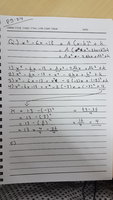GhettoBurger
New member
- Joined
- May 19, 2019
- Messages
- 3
I am currently going through a book called no bullshit guide to math and physics, and am puzzled by an exercise given early on in the book.
The question states x^2 − 6x + 13 = (x − 3)^2 + 4
In the chapter it goes on to state that any quadratic expression Ax^2 + Bx + C can be rewritten in the form A(x − h)^2 + k. Keeping this in mind I attempt to solve the question above.
I have done the equation as posted in the image below. But the final step which should give me the result (x − 3)^2 + 4 I am unable to reach. Could give me some guidance as to what I am doing incorrectly.

The question states x^2 − 6x + 13 = (x − 3)^2 + 4
In the chapter it goes on to state that any quadratic expression Ax^2 + Bx + C can be rewritten in the form A(x − h)^2 + k. Keeping this in mind I attempt to solve the question above.
I have done the equation as posted in the image below. But the final step which should give me the result (x − 3)^2 + 4 I am unable to reach. Could give me some guidance as to what I am doing incorrectly.

